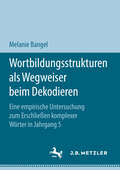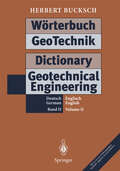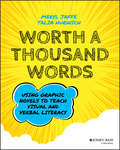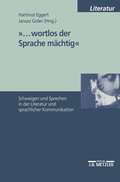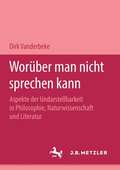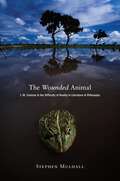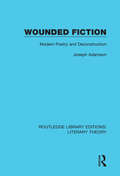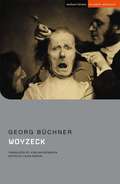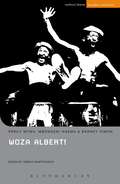- Table View
- List View
Wortbildung: Grundlagen einer kognitiven Wortsemantik (Psycholinguistische Studien)
by Mechthild RickheitWortbildungsstrukturen als Wegweiser beim Dekodieren: Eine empirische Untersuchung zum Erschließen komplexer Wörter in Jahrgang 5
by Melanie BangelMelanie Bangel geht in dieser Studie der Frage nach, inwiefern stärkere und schwächere Leserinnen und Leser Einsicht in Wortbildungsstrukturen für die Bedeutungszuweisung beim Lesen nutzen. Dazu erhebt sie (retrospektive) metakognitive Verbalprotokolle mit Schülerinnen und Schülern in Jahrgang 5 über die Bedeutung von kontextuell eingebetteten und isoliert schriftlich präsentierten komplexen Wörtern sowie über die den Bedeutungshypothesen zugrundeliegenden Worterschließungsstrategien. In den Analysen kommen unterschiedliche Vorstellungen zum Zusammenhang zwischen Wort(bildungs)struktur und Bedeutung zum Vorschein. Die Ergebnisse zeigen, dass sich die lesestärkeren und leseschwächeren Schülerinnen und Schüler vor allem darin unterscheiden, inwiefern sie den Kotext als Informationsquelle hinzuziehen und ob sie morphologisches Wissen als wortübergreifendes Problemlösewissen abrufen können.
Wörterbuch GeoTechnik Dictionary Geotechnical Engineering: Band II / Volume II
by Herbert BuckschDie beiden Bände des Wörterbuchs GeoTechnik enthalten zusammen etwa 140.000 Eintragungen. Zu jedem Stichwort werden gebräuchliche Synonyme aufgeführt. Zum besseren Verständnis finden sich unter einigen Stichwörtern zusätzliche Erläuterungen. Neben Begriffen aus der allgemeinen Geologie deckt das Wörterbuch insbesondere die eher anwendungsorientierten Themenbereiche der Geowissenschaften ab. Schwerpunktmäßig werden folgende Gebiete behandelt: - Bergbau, - Bodenkunde, - Erdbau, - Erkundungsgeologie, - Geophysik, - Geomorphologie, - Grundbau, - Hydrogeologie,- Hydrotechnik, - Ingenieurgeologie, - Kartographie,- Lagerstättenkunde, - Mineralogie, - Ozeanographie,- Vermessungswesen.
Wörterbuch zur deutschen Literatur (Teubners kleine Fachwörterbücher #14)
by Hans RöhlDieser Buchtitel ist Teil des Digitalisierungsprojekts Springer Book Archives mit Publikationen, die seit den Anfängen des Verlags von 1842 erschienen sind. Der Verlag stellt mit diesem Archiv Quellen für die historische wie auch die disziplingeschichtliche Forschung zur Verfügung, die jeweils im historischen Kontext betrachtet werden müssen. Dieser Titel erschien in der Zeit vor 1945 und wird daher in seiner zeittypischen politisch-ideologischen Ausrichtung vom Verlag nicht beworben.
Worth A Thousand Words: Using Graphic Novels to Teach Visual and Verbal Literacy
by Meryl Jaffe Talia HurwichUse graphic novels to teach visual and verbal literacy While our kids today are communicating outside the classroom in abbreviated text bursts with visual icons, teachers are required to teach them to critically listen, think, and read and write complex texts. Graphic novels are a uniquely poised vehicle we can use to bridge this dissonance between student communication skills and preferences with mandated educational goals. Worth a Thousand Words details how and why graphic novels are complex texts with advanced-level vocabulary, and demonstrates how to read and analyze these texts. It includes practical advice on how to integrate these books into both ELA and content-area classrooms and provides an extensive list of appropriate graphic novels for K-8 students, lesson suggestions, paired graphic/prose reading suggestions, and additional resources for taking these texts further. Provides research to back up why graphic novels are such powerful educational tools Helps you engage diverse student learners with exciting texts Shows you how to make lessons more meaningful Offers advice on implementing new literary mediums into your classroom Perfect for parents and teachers in grades K-8, Worth a Thousand Words opens up an exciting new world for teaching children visual and verbal literacy.
Worth A Thousand Words: Using Graphic Novels to Teach Visual and Verbal Literacy
by Meryl Jaffe Talia HurwichUse graphic novels to teach visual and verbal literacy While our kids today are communicating outside the classroom in abbreviated text bursts with visual icons, teachers are required to teach them to critically listen, think, and read and write complex texts. Graphic novels are a uniquely poised vehicle we can use to bridge this dissonance between student communication skills and preferences with mandated educational goals. Worth a Thousand Words details how and why graphic novels are complex texts with advanced-level vocabulary, and demonstrates how to read and analyze these texts. It includes practical advice on how to integrate these books into both ELA and content-area classrooms and provides an extensive list of appropriate graphic novels for K-8 students, lesson suggestions, paired graphic/prose reading suggestions, and additional resources for taking these texts further. Provides research to back up why graphic novels are such powerful educational tools Helps you engage diverse student learners with exciting texts Shows you how to make lessons more meaningful Offers advice on implementing new literary mediums into your classroom Perfect for parents and teachers in grades K-8, Worth a Thousand Words opens up an exciting new world for teaching children visual and verbal literacy.
Worth Writing About: Exploring Memoir with Adolescents
by Jake WiznerWho am I? This is the question that many adolescents ask during the turbulent middle and high school years. In Worth Writing About: Exploring Memoir with Adolescents, Jake Wizner addresses how searching for the answer to this question leads his students to reflection, to reading, and ultimately to deeper, more meaningful writing. Wizner, a 20-year teaching veteran, believes that a well-designed memoir unit not only aligns with the Common Core State Standards but also forges community in the classroom, encourages kids to read nonfiction, and works wonders with students who struggle with their writing'sor with their lives.Worth Writing About addresses the most common challenges teachers face when teaching memoir writing: How do you help students who say that nothing interesting has happened in their lives? How do you help students balance what is meaningful with what is too personal to share? How do you help students overcome the I don't remember syndrome?Wizner delves into the craft of writing, from using mentor texts to crafting leads and memorable endings. He uses student models from his own classroom to show the deep, important work his students produce during the memoir unit. By writing about themselves and how they view the world around them, students discover more about themselves and how they want to move forward in the future.
Worth Writing About: Exploring Memoir with Adolescents
by Jake WiznerWho am I? This is the question that many adolescents ask during the turbulent middle and high school years. In Worth Writing About: Exploring Memoir with Adolescents, Jake Wizner addresses how searching for the answer to this question leads his students to reflection, to reading, and ultimately to deeper, more meaningful writing. Wizner, a 20-year teaching veteran, believes that a well-designed memoir unit not only aligns with the Common Core State Standards but also forges community in the classroom, encourages kids to read nonfiction, and works wonders with students who struggle with their writing'sor with their lives.Worth Writing About addresses the most common challenges teachers face when teaching memoir writing: How do you help students who say that nothing interesting has happened in their lives? How do you help students balance what is meaningful with what is too personal to share? How do you help students overcome the I don't remember syndrome?Wizner delves into the craft of writing, from using mentor texts to crafting leads and memorable endings. He uses student models from his own classroom to show the deep, important work his students produce during the memoir unit. By writing about themselves and how they view the world around them, students discover more about themselves and how they want to move forward in the future.
"...wortlos der Sprache mächtig": Schweigen und Sprechen in Literatur und sprachlicher Kommunikation
Beredtes Schweigen wie verschwiegenes Reden können subtile Phänomene im Alltag sein. In kulturellen und politischen Konstellationen gewinnen sie andere Dimensionen, von denen die Literatur zeugt. Die Zuspitzung dieser Polarität als problematisches Spannungsverhältnis im 20. Jahrhundert verweist auf Gewalt- und Machtpotentiale, die sich auf menschliche Kommunikationsformen ausgewirkt haben. Zwanzig Literatur- und Sprachwissenschaftler der Germanistik der Freien Universität Berlin, der Marii Curie-Sklodowskiej Universytet Lublin und anderer polnischer Universitäten widmen sich diesem Thema in Beiträgen zur mystischen Tradition, zu bedeutenden literarischen Texten von Kafka bis Hanna Krall, zur politischen Propaganda sowie zu Gestik und Pausen in konkreten Konversationssituationen. Die FU Berlin und UMCS Lublin verbindet eine germanistische Institutspartnerschaft, die vom DAAD unterstützt wird. In diesem Kooperationsrahmen fand das Symposium im Mai 1998 in der Nähe von Lublin statt.
Wortschatzuntersuchung: Das normale Kind (Forschungsberichte des Landes Nordrhein-Westfalen #2682)
by Walter Rest Karl Brose Peter Heitkämper Siegfried NeumannHier 5011 über ein Forschungsprojekt berichtet werden, das in den Jahren 1975 und 1976 in einer Stadtrand Grundschule durchgeführt wurde, in der seit vielen Jahren von vier Kollegen die Praktika zur Einführung in die Schulwirklichkeit vonseiten der Pädagogischen Hochschule Westfalen-Lippe, Abteilung Münster, geleitet wurden. Das verantwortliche Kollegen-Team befaBte sich hierbei mehrere Semester hindurch mit Fragen der Friedens erziehung in einer "normalen" Grundschule, also in einer Schule, wie sie allgemein im Lande NRW verbreitet ist. Das Forschungsprojekt bezog sich auf das Einzugs gebiet, wie es durch den Schulbezirk festgelegt war. Wir hatten es insofern mit "normalen" Kindern einer öffentlichen Gemeinschafts-Grundschule zu tun, also mit Kindern, die den Aufnahmebedingungen nach amtlichen Grundsätzen entsprachen. Sonderprobleme, wie sie oft bei Schulkindern untersucht werden, wurden nicht eigens in Betracht gezogen, das Projekt bezog sich auf "Wort schatzuntersuchungen: Das normale Kind." Wir woUten von den Gegebenheiten ohne irgendwelche "Sanktionen" in psychologischer oder soziologischer Hinsicht ausgehen und den Befund empirisch-pädagogisch untersuchen.
Worüber man nicht sprechen kann: Aspekte der Undarstellbarkeit in Philosophie, Naturwissenschaft und Literatur
by Dirk VanderbekeThe Wounded Animal: J. M. Coetzee and the Difficulty of Reality in Literature and Philosophy
by Stephen MulhallIn 1997, the Nobel Prize-winning novelist J. M. Coetzee, invited to Princeton University to lecture on the moral status of animals, read a work of fiction about an eminent novelist, Elizabeth Costello, invited to lecture on the moral status of animals at an American college. Coetzee's lectures were published in 1999 as The Lives of Animals, and reappeared in 2003 as part of his novel Elizabeth Costello; and both lectures and novel have attracted the critical attention of a number of influential philosophers--including Peter Singer, Cora Diamond, Stanley Cavell, and John McDowell. In The Wounded Animal, Stephen Mulhall closely examines Coetzee's writings about Costello, and the ways in which philosophers have responded to them, focusing in particular on their powerful presentation of both literature and philosophy as seeking, and failing, to represent reality--in part because of reality's resistance to such projects of understanding, but also because of philosophy's unwillingness to learn from literature how best to acknowledge that resistance. In so doing, Mulhall is led to consider the relations among reason, language, and the imagination, as well as more specific ethical issues concerning the moral status of animals, the meaning of mortality, the nature of evil, and the demands of religion. The ancient quarrel between philosophy and literature here displays undiminished vigor and renewed significance.
The Wounded Animal: J. M. Coetzee and the Difficulty of Reality in Literature and Philosophy
by Stephen MulhallIn 1997, the Nobel Prize-winning novelist J. M. Coetzee, invited to Princeton University to lecture on the moral status of animals, read a work of fiction about an eminent novelist, Elizabeth Costello, invited to lecture on the moral status of animals at an American college. Coetzee's lectures were published in 1999 as The Lives of Animals, and reappeared in 2003 as part of his novel Elizabeth Costello; and both lectures and novel have attracted the critical attention of a number of influential philosophers--including Peter Singer, Cora Diamond, Stanley Cavell, and John McDowell. In The Wounded Animal, Stephen Mulhall closely examines Coetzee's writings about Costello, and the ways in which philosophers have responded to them, focusing in particular on their powerful presentation of both literature and philosophy as seeking, and failing, to represent reality--in part because of reality's resistance to such projects of understanding, but also because of philosophy's unwillingness to learn from literature how best to acknowledge that resistance. In so doing, Mulhall is led to consider the relations among reason, language, and the imagination, as well as more specific ethical issues concerning the moral status of animals, the meaning of mortality, the nature of evil, and the demands of religion. The ancient quarrel between philosophy and literature here displays undiminished vigor and renewed significance.
The Wounded Body: Memory, Language and the Self from Petrarch to Shakespeare
by Fabrizio Bondi Massimo Stella Andrea TorreThis edited collection explores the image of the wound as a ‘cultural symptom’ and a literary-visual trope at the core of representations of a new concept of selfhood in Early Modern Italian and English cultures, as expressed in the two complementary poles of poetry and theatre. The semantic field of the wounded body concerns both the image of the wound as a traumatic event, which leaves a mark on someone’s body and soul (and prompts one to investigate its causes and potential solutions), and the motif of the scar, which draws attention to the fact that time has passed and urges those who look at it to engage in an introspective and analytical process. By studying and describing the transmission of this metaphoric paradigm through the literary tradition, the contributors show how the image of the bodily wound—from Petrarch’s representation of the Self to the overt crisis that affects the heroes and the poetic worlds created by Ariosto and Tasso, Spenser and Shakespeare—could respond to the emergence of Modernity as a new cultural feature.
Wounded Fiction: Modern Poetry and Deconstruction (Routledge Library Editions: Literary Theory)
by Joseph AdamsonThis book, first published in 1988, does not concern the theory of poetry so much as the poetry of theory: a poetry that theorizes, that has a "view" on things, that thinks. What or what things does poetry think about, and what do we mean by thinking? The author attempts to answer these questions by examining the work of three poets – Wallace Stevens, César Vallejo, and René Char – and reflects upon the poetry itself. This title will be of interest to students of literature and literary theory.
Wounded Fiction: Modern Poetry and Deconstruction (Routledge Library Editions: Literary Theory)
by Joseph AdamsonThis book, first published in 1988, does not concern the theory of poetry so much as the poetry of theory: a poetry that theorizes, that has a "view" on things, that thinks. What or what things does poetry think about, and what do we mean by thinking? The author attempts to answer these questions by examining the work of three poets – Wallace Stevens, César Vallejo, and René Char – and reflects upon the poetry itself. This title will be of interest to students of literature and literary theory.
The Wounded Hero in Contemporary Fiction: A Paradoxical Quest (Routledge Studies in Contemporary Literature)
by Susana Onega Jean-Michel GanteauThe Wounded Hero in Contemporary Fiction tracks the emergence of a new type of physically and/or spiritually wounded hero(ine) in contemporary fiction. Editors, Susana Onega and Jean-Michel Ganteu bring together some of the top minds in the field to explore the paradoxical lives of these heroes that have embraced, rather than overcome, their suffering, alienation and marginalisation as a form of self-definition.
The Wounded Hero in Contemporary Fiction: A Paradoxical Quest (Routledge Studies in Contemporary Literature)
by Susana Onega Jean-Michel GanteauThe Wounded Hero in Contemporary Fiction tracks the emergence of a new type of physically and/or spiritually wounded hero(ine) in contemporary fiction. Editors, Susana Onega and Jean-Michel Ganteu bring together some of the top minds in the field to explore the paradoxical lives of these heroes that have embraced, rather than overcome, their suffering, alienation and marginalisation as a form of self-definition.
Wounds, Flesh, and Metaphor in Seventeenth-Century England
by S. CovingtonWounds, Flesh and Metaphor in Seventeenth-Century England explores the theme of physical and symbolic woundedness in mid-seventeenth century English literature. This book demonstrates the ways in which writers attempted to represent the politically and religiously fractured state of the time and re-imagined the nation through language and metaphor in the process. By examining the creative permutations of the wound metaphor, Covington argues for the centrality of the charged imagery, and language itself, in shaping the self-representations of an age.
Woyzeck (Student Editions)
by Georg BüchnerWritten in 1836, Woyzeck is often considered to be the first truly modern play.The story of a soldier driven mad by inhuman military discipline and acute social deprivation is told in splintered dialogue and jagged episodes, which are as shocking and telling today as they were when first performed, almost a century after the author's death, in Munich 1913.This edition contains introductory commentary and notes by Laura Martin from the University of Glasgow. METHUEN DRAMA STUDENT EDITIONS are expertly annotated texts of a wide range of plays from the modern and classic repertoires. A well as the complete text of the play itself, this volume contains:· A chronology of the play and the playwright's life and work· an introductory discussion of the social, political, cultural and economic context in which the play was originally conceived and created· a succinct overview of the creation processes followed and subsequent performance history of the piece· an analysis of, and commentary on, some of the major themes and specific issues addressed by the text· a bibliography of suggested primary and secondary materials for further study.
Woyzeck (Student Editions)
by Georg BüchnerWritten in 1836, Woyzeck is often considered to be the first truly modern play.The story of a soldier driven mad by inhuman military discipline and acute social deprivation is told in splintered dialogue and jagged episodes, which are as shocking and telling today as they were when first performed, almost a century after the author's death, in Munich 1913.This edition contains introductory commentary and notes by Laura Martin from the University of Glasgow. METHUEN DRAMA STUDENT EDITIONS are expertly annotated texts of a wide range of plays from the modern and classic repertoires. A well as the complete text of the play itself, this volume contains:· A chronology of the play and the playwright's life and work· an introductory discussion of the social, political, cultural and economic context in which the play was originally conceived and created· a succinct overview of the creation processes followed and subsequent performance history of the piece· an analysis of, and commentary on, some of the major themes and specific issues addressed by the text· a bibliography of suggested primary and secondary materials for further study.
Woza Albert! (Student Editions)
by Percy Mtwa Mbongeni Ngema Barney Simon Temple HauptfleischWoza Albert! is one of the most popular and influential plays to have come out of the South African cultural struggle of the 1980s and a central work in the canon of South African theatre. Working with the idea of the Second Coming of Jesus Christ taking place in apartheid South Africa, the playwrights improvised a brilliant two-man show consisting of 26 vignettes, commenting on and satirising life under the apartheid regime. The play has become one of the most anthologized and produced South African plays both in South Africa, and internationally and is studied widely in schools as well as universities. This Student Edition contains a commentary and notes by Temple Hauptfleisch, Emeritus Professor at Stellenbosch University, South Africa. METHUEN DRAMA STUDENT EDITIONS are expertly annotated texts of a wide range of plays from the modern and classic repertoires. A well as the complete text of the play itself, this volume contains: · A contextualised chronology of the play and the playwrights' lives and works· an introductory discussion of the social, political, cultural and economic context in which the play was originally conceived and created· a succinct overview of the creation processes followed and subsequent performance history of the piece· an analysis of, and commentary on, some of the major themes and specific issues addressed by the text· a bibliography of suggested primary and secondary materials.
Woza Albert!: A Study Guide (Student Editions)
by Percy Mtwa Mbongeni Ngema Barney Simon Temple HauptfleischWoza Albert! is one of the most popular and influential plays to have come out of the South African cultural struggle of the 1980s and a central work in the canon of South African theatre. Working with the idea of the Second Coming of Jesus Christ taking place in apartheid South Africa, the playwrights improvised a brilliant two-man show consisting of 26 vignettes, commenting on and satirising life under the apartheid regime. The play has become one of the most anthologized and produced South African plays both in South Africa, and internationally and is studied widely in schools as well as universities. This Student Edition contains a commentary and notes by Temple Hauptfleisch, Emeritus Professor at Stellenbosch University, South Africa. METHUEN DRAMA STUDENT EDITIONS are expertly annotated texts of a wide range of plays from the modern and classic repertoires. A well as the complete text of the play itself, this volume contains: · A contextualised chronology of the play and the playwrights' lives and works· an introductory discussion of the social, political, cultural and economic context in which the play was originally conceived and created· a succinct overview of the creation processes followed and subsequent performance history of the piece· an analysis of, and commentary on, some of the major themes and specific issues addressed by the text· a bibliography of suggested primary and secondary materials.
Wozu braucht der Mensch Dichtung?: Anthropologie und Poetik von Platon bis Musil
by Ulrich GaierDieses Buch geht einer anthropologischen Frage nach: „Wozu braucht der Mensch Dichtung?“ Die Antworten von Philosophen und Dichtern von der Antike bis ins 20. Jahrhundert stehen im Mittelpunkt. Theoretiker der Antike wie Gorgias, Platon, Aristoteles, Plotin, Proklos kommen zu Wort. Geistliche und Ritter des Mittelalters geben die immanente Poetik ihrer Dichtungen preis. Dichter-Anthropologen wie Ficino, Brant, die Emblematiker, europäische Anthropologen und Lehrer der Dichtkunst reflektieren über den Sinn und die Notwendigkeit von Dichtung. Mit aufschlussreichen Beispielen aus dem europäischen Roman, dem europäischen Drama und der Ballade des 19. und 20. Jahrhunderts können auch noch die Hauptgattungen poetologisch und anthropologisch in ihrem Ursprung, Sinn und Wirkungspotential erfasst werden.

